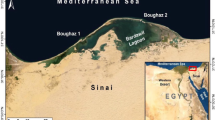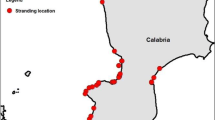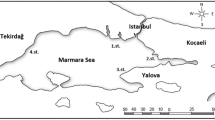Abstract
The aim of this study was to bio monitor the status of heavy metals on the southern shores of the Caspian Sea by determining the concentration of these metals in the tissue of Rutilus kutum. Sampling of kidney tissue, liver, muscle, skin, and gonad of this fish was performed in 5 sites. Sampling was performed in Anzali, Kiashahr, Astara, Farahabad, and Bandar Torkaman from September 2017 to January 2018. In this study, the concentration of elements in different tissues was determined. Contamination zonation was determined by the concentration of metals in fish tissues. The highest amount of Pb accumulation (0.73 ppb) was determined in Astara and Anzali regions and in liver tissue. The highest amount of Cd (0.23 ppb) was reported in Astara region and in fish liver. Zoning showed that the concentration of most elements in the west of the Caspian Sea is higher than in the east; in other words, the west of the Caspian Sea is more polluted than the east. Existence of polluting sources such as ports, customs, agricultural lands, and tourism industry are important factors of pollution in these areas. Annual biological monitoring along with accurate identification of pollutant sources can help reduce this pollution, especially in the western part of the Caspian Sea. This study showed that the use of zoning technique in environmental studies as an effective management tool can be very useful in providing appropriate ways to identify and control sources and pollutants in the coast.






Similar content being viewed by others
Data Availability
All data in this article will be available upon request.
References
Aliko V, Qirjo M, Sula E, Morina V, Faggio C (2018) Antioxidant defense system, immune response and erythron profile modulation in Gold fish, Carassius auratus, after acute manganese treatment”. Fish Shellfish Immunol 76:101–109
Al-Sayed H, Al-Saad J, Madany I, Al-Hooti D (1996) Heavy metals in the grouper fish Epinephelus coioides from the coast of Bahrain: an assessment of monthly and spatial trends. Int J Environ Stud 50:237–246
Amini Ranjbar Gh, Sotudehnia F (2005) Investigation of heavy metals accumulation in muscle tissue of (Mugil auratus) in relation to standard length weight age and sex. Iran Fish Sci J 14:1–18 ((in Persian))
Bibak M, Sattari M, Agharokh A, Tahmasebi S, Imanpour Namin J (2018) Assessing some heavy metals pollutions in sediments of the northern Persian Gulf (Bushehr province). J Environ Health Sci Eng 5(3):175–179
Bibak M, Sattari M, Agharokh A, Tahmasebi S, Imanpour Namin J (2020) Marine macro algae as a bio-indicators of heavy metal pollution in the marine environments. Persian Gulf Indian J Mar Sci 49(3):357–363
Bibak M, Sattari M, Tahmaseb S, Kafaei R, Sorial GA, Ramavandi B (2021) Trace and Major Elements Concentration in Fish and Associated Sediment–Seawater, Northern Shores of the Persian Gulf. Biol Trace Elem Res. https://doi.org/10.1007/s12011-020-02370-x
Bibak M, Tahmasebi S, Sattari M, Kafaei R, Ramavandi B (2021) Empirical cumulative entropy as a new trace elements indicator to determine the relationship between algae-sediment pollution in the Persian Gulf, southern Iran. Environ Sci Pollut Res 28:4634–4644. https://doi.org/10.1007/s11356-020-10838-5
Blakas T, Tugrel S, Salhogln I (1982) Trace metal levels in fish and crustaceans from Northeastern Mediterranean coastal waters. Mar Environ Res 6:281–289
Boran M, Karacam H, Celikkale MS, Kose S, Feyzioglu M, Kutlu S (2000) Levels of heavy metals in blue whiting caught from the eastern Black Sea area of Turkey. Toxicol Environ Chem 75:67–73
Burgos-Aceves MA, Cohen A, Smith Y, Faggio C (2018) MicroRNAs and their role on fish oxidative stress during xenobiotic environmental exposures. Ecotoxicol Environ Saf 148:995–1000
Capillo G, Silvestro S, Sanfilippo M, Fiorino E, Giangrosso G, Ferrantelli V, Vazzana I, Faggio C (2018) Assessment of electrolytes and metals profile of the Faro Lake (Capo Peloro Lagoon, Sicily, Italy) and its impact on Mytilus galloprovincialis. Chem Biodivers. https://doi.org/10.1002/cbdv.201800044
Eslami S, Moghaddam AH, Jafari N, Nabavi SF, Nabavi SM, Ebrahimzadeh MA (2011) Trace element level in different tissues of Rutilus frisii kutum collected from Tajan River. Iran Biol Trace Elem Res 143:965–973
Fazio F, Piccione G, Tribulato K, Ferrantelli V, Giangrosso G, Arfuso F, Faggio C (2014) Bioaccumulation of Heavy Metals in Blood and Tissue of Striped Mullet in Two Italian Lakes. J Aquat Anim Health 26:278–284
Forouhar Vajargah M, Sattari M, Imanpour Namin J, Bibak M (2021) Evaluation of trace elements contaminations in skin tissue of Rutilus kutum Kamensky 1901 from the south of the Caspian Sea. J Adv Environ Health Res. 9(2): https://doi.org/10.22102/jaehr.2021.259190.1201
Hosseini SV, Sobhanardakani S, Miandare HK, Harsij M, Mac Regenstein J (2015) Determination of toxic (Pb, Cd) and essential (Zn, Mn) metals in canned tuna fish produced in Iran. J Environ Health Sci Eng 13(1):1–6
Hung T, Huang Ch, Pei-Jie A, Chuang S, Wu H (1999) Heavy metals in fish tissues and different species of fish from the southern coast of Taiwan. Chem Ecol 16:283–296
Ibrayev RA, O¨zsoy E, Schrum C, Sur HI (2010) Seasonal variability of the Caspian Sea
Khalil M, Faragallah H (2008) The distribution of some leachable and total heavy metals in core sediments of Manzala lagoon. Egypt J Aquat Res 34(1):1-11.34
Khanipour AA, Ahmadi M, Seifzadeh M (2018) Study on bioaccumulation of heavy metals (cadmium, nickel, zinc and lead) in the muscle of Wels catfish (Silurus glanis) in the Anzali Wetland, Iran. J Fish Sci 17(1):244–250
Kim J, Jun MJ, Yeo CH, Kwon KH, Hyun JY (2019) The Effects of Land Use Zoning and Densification on Changes in Land Surface Temperature in Seoul. Sustainability 11:7056. https://doi.org/10.3390/su11247056
Kotze PJ, Du Pree HH, Vuren van JHJ (1999) Bioaccumulation of Copper and Zinc in (Oreochromis mossamicus) and (Clarias gariepinus), from the Olifants River, Mpumalanga, South Africa. 12 p.
Mokarram M, Obaidi R, Dolah AH, Nourbakhsh HZ (2020) Investigation of some heavy metals in Assaluyeh port waters and its effect on Brachirus orientalis & Scomberomorus guttatus muscle environment in GSI. Scientific J. Mar. Biol. / Islamic Azad University, Ahvaz Branch. 12 (44): 83–96.
Munoz-Olivas R, Camara C (2001) Speciation related to human health, In: L, Ebdon, L, Pitts, R, Cornelis, H, Crews, OFX, Donad, P, Quevauviller, (Eds.), Trace Element Speciation for Environment, Food and Health. The Royal Society of Chemistry, 331–353.
Norouzi M, Bagheri Tavani M (2016) Monitoring of lead and cadmium contamination in the southern basin of the Caspian Sea by Liza aurata using GIS system. J Aquat Ecol 6(2):101–115 (In Persian)
Pagano M, Porcino C, Briglia M, Fiorino E, Vazzana M, Silvestro S, Faggio C (2017) The influence of exposure of cadmium chloride and zinc chloride on haemolymph and digestive gland cells from Mytilus galloprovincialis. Int J Environ Res 11(2):207–216
Roshan G, Moghbel M, Grab S (2012) Modeling Caspian Sea water level oscillations under different scenarios of increasing atmospheric carbon dioxide concentrations. Iranian J Environ Health Sci Eng 9:1–10
Sattari M, Bibak M, Bakhshalizadeh S, Vajargah MF (2020) Element Accumulations in Liver and Kidney Tissues of Some Bony Fish Species in the Southwest Caspian Sea. JCMR 12(1):33–40
Sattari M, ImanpourNamin J, Bibak M, ForouharVajargah M, Mazareiy MH (2020) Trace elements contamination in Alosabraschnikowi of the southern basins of Caspian Sea-Guilan Province. J Anim Ecol 12(3):115–22
Sattari M, Majidi S, Bibak M, ForouharVajargah M (2020) Investigating the relationship between some element concentrations in liver and muscle of Vimba persa and growth indices during different seasons in the southwest coasts of the Caspian Sea. J Aquac Res Dev 14(3):43–53
Sattari M, Namin JI, Bibak M, Vajargah MF, Bakhshalizadeh S, Faggio C (2019) Determination of Trace Element Accumulation in Gonads of Rutilus kutum (Kamensky, 1901) from the South Caspian Sea Trace Element Contaminations in Gonads. Proc Natl Acad. Sci India Sect B Biol Sci 11:1–8
Sattari M, Vajargah MF, Bibak M, Bakhshalizadeh S (2020) Relationship Between Trace Element Content in the Brain of Bony Fish Species and Their Food Items in the Southwest of the Caspian Sea Due to Anthropogenic Activities. Avicenna J Environ Health Eng. 7(2):78–85. https://doi.org/10.34172/ajehe.2020.12
Sattari M, Namin JI, Bibak M, Vajargah MF, Hedayati A, Khosravi A, Mazareiy MH (2019) Morphological comparison of western and eastern populations of Caspian kutum, Rutilus kutum (Kamensky, 1901)(Cyprinidae) in the southern Caspian Sea. Int J Aquat Biol 6(4):242–247
Savorelli F, Manfra L, Croppo M, Tornambè A, Palazzi D, Canepa S, Trentini PL, Cicero AM, Faggio C (2017) Fitness evaluation of Ruditapes philippinarum exposed to nickel. Biol Trace Elem Res 177(2):384–393
Seco-Gesto EM, Moreda-Piñeiro A, BermejoBarrera A, Bermejo-Barrera P (2007) Multi-element determination in raft mussels by fast microwave assisted acid leaching and inductively co upled plasma-optical emission spectrometry. Talanta 72:1178
Sobhanardakani S (2017) Potential health risk assessment of heavy metals via consumption of caviar of Persian sturgeon. Mar Pollut Bull 123(1–2):34–38
Sobhanardakani S (2018) Human health risk assessment of potentially toxic heavy metals in the atmospheric dust of city of Hamedan, west of Iran. Environ Sci Pollut Res 25(28):28086–28093
Sobhanardakani S (2019) Ecological and human health risk assessment of heavy metal content of atmospheric dry deposition, a case study: Kermanshah, Iran. Biol. Trace Elem. Res. 187(2).
Sobhanardakani S, Tayebi L, Hosseini SV (2018) Health risk assessment of arsenic and heavy metals (Cd, Cu Co, Pb, and Sn) through consumption of caviar of Acipenser persicus from Southern Caspian Sea. Environ Sci Pollut Res 25(3):2664–2671
Stephen M, Sheikholeslami M (2002) Final report: interpretation of Caspian Sea sediment data. Suez. Red Sea J Mar Syst 60:220–234
Tabelinova AS (2020) Geoecological Zoning of the Northeastern Caspian. Arid Ecosyst 10(3):211–218
Tariq JMM, Moazzam M (1991) Concentration correlations between major cations and heavy metals in fish from the Arabian Sea. Mar Pollut Bull 22(11):562–565
Torre A, Trischitta F, Faggio C (2013) Effect of CdCl2 on Regulatory Volume Decrease (RVD) in Mytilus galloprovincialis digestive cells. Toxicol In Vitro 27:1260–1266
Türkmen M, Türkmen AY, Tepe Y (2007) Metal contaminations in five fish species from Black, Marmara, Aegean and Mediterranean seas, Turkey. J Chil Chem Soc 52(4):1314–1318
Vajargah MF (2021) A Review on the Effects of Heavy Metals on Aquatic Animals. Environ. Sci. 2(9).
Vajargah MF, Mohsenpour R, Yalsuyi AM, Galangash MM, Faggio C (2021) Evaluation of Histopathological Effect of Roach (Rutilus rutilus caspicus) in Exposure to Sub-Lethal Concentrations of Abamectin. Water Air Soil Pollut 232(5):1–8
Vajargah MF, Sattari M, Namin JI, Bibak M (2021) Predicting the Trace Element Levels in Caspian Kutum (Rutilus kutum) from South of the Caspian Sea Based on Locality, Season and Fish Tissue. Mar Pollut Bull 12:1. https://doi.org/10.1007/s12011-021-02622-4
Valova Z, Jurajda P, Janač M, Bernardova I, Hudcova H (2010) Spatiotemporal trends of heavy metal concentrations in Fish of the River Morava (Danube basin). J Environ Sci Health Part A Tox Hazard Subst Environ Eng 45:1892–1899
Visnjic-Jeftic Z, Jaric I, Jovanovic L, Skoric S, Smederevac-Lalic M, Nikcevic M, Lenhardt M (2010) Heavy metal and trace element accumulation in muscle, liver and gills of the Pontic shad (Alosa immaculata Bennet 1835) from the Danube River (Serbia). Microchem J 95(2):341–344. https://doi.org/10.1016/j.microc.02.004
Yalsuyi AM, Hedayati A, Vajargah MF, Mousavi-Sabet H (2017) Examining the toxicity of cadmium chloride in common carp (Cyprinus carpio) and goldfish (Carassius auratus). J environ treat tech 5(2):83–86
Yalsuyi AM, Vajargah MF (2017) Recent advance on aspect of fisheries: A review. J Coast Life Med 5(4):141–148
Yilmaz TI, Dusch F, Di Genova D (2016) Feathery and network-like filamentous textures as indicators for the re-crystallization of quartz from a metastable silica precursor at the Rusey Fault Zone, Cornwall. UK Solid Earth 7:1509–1519. https://doi.org/10.5194/se-7-1509-2016
Zangane P, Lakan K (2007) The concentration of heavy metals in surface sediments of the Caspian Sea in Iran. J Water Wastewater 63:1–12 ((in Persian))
Zhou JL, Salavador SM, Liu YP, Sequeria M (2001) Heavy metals in the tissues of common dolphins (Delphinus delphis) stranded on the Portuguese coast. Sci Total Environ 273:61
Author information
Authors and Affiliations
Contributions
Mohammad Forouhar Vajargah: investigation, methodology, validation; Mehdi Bibak: writing-data analysis- software.
Corresponding author
Ethics declarations
Ethics Approval
The study protocol and ethics of this work have been approved by the Ethical Committee of the University of Guilan.
Consent to Participate
No human was used in this work.
Consent for Publication
All the authors agreed to publish the data in this journal.
Conflict of Interest
The authors declare no competing interests.
Additional information
Publisher's Note
Springer Nature remains neutral with regard to jurisdictional claims in published maps and institutional affiliations.
Rights and permissions
About this article
Cite this article
Forouhar Vajargah, M., Bibak, M. Pollution zoning on the southern shores of the Caspian Sea by measuring metals in Rutilus kutum tissue. Biol Trace Elem Res 200, 4465–4475 (2022). https://doi.org/10.1007/s12011-021-03023-3
Received:
Accepted:
Published:
Issue Date:
DOI: https://doi.org/10.1007/s12011-021-03023-3




